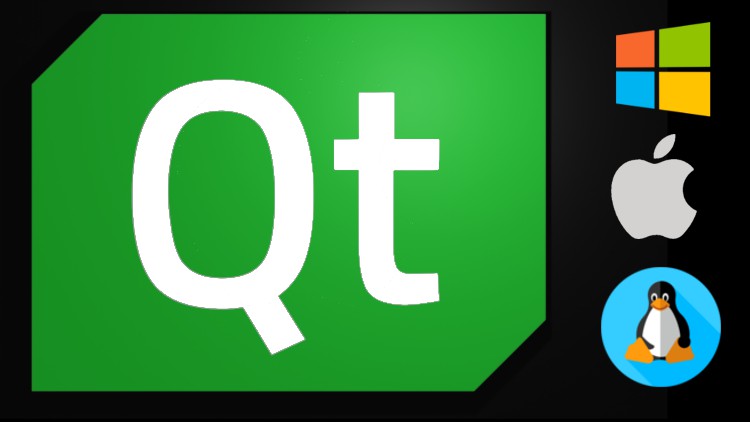Qt 6 Core Advanced with C++
- Description
- Curriculum
- FAQ
- Reviews
This is not a beginners course!
This is an advanced Qt 6 course using C++ to create high performance applications on Windows, Mac and Linux. This course also includes advanced topics such as threading, networking, libraries, plugins, databases, unit testing, and application deployment.
This is a followup to the Udemy Qt 5 Core for beginners and intermediate courses and picks up where they both left off. It is highly recommended to take those courses before attempting this one. In this course you will learn how to work with threads, sockets, libraries, plugins, unit testing, and application deployment across multiple operating systems.
Threading
Threads help make your applications lighting fast. You will learn threading best practices, along with some common misconceptions and mistakes. Additionally we will dive into thread pools which are highly fast and efficient use of threads. And we will cover how to simplify threading using the Qt Concurrent Library.
Networking
We will cover general networking concepts along with who to use both TCP and UDP sockets to communicate with remote servers. This course also covers how to use SSL encryption to maintain a secure connection with the remote host. Later on in the networking section we will demonstrate how to make a basic TCP server, then combine threading and SSL to make a high performance TCP server that can handle a lot of simultaneous connections.
Libraries
We will teach what libraries are, and how you can easily create your own libraries along with how to use libraries created by other developers. This course also covers shared vs static libraries, and even how to make your application expandable by developing a simple plugin system that allows you to dynamically add functionality to your application while its running without recompiling your application.
Databases
This is a broad topic and we will show just the basics of how to use the Qt SQL libraries and vendor drivers to connect to and use databases. We do demonstrate a few concepts using MySql.
Testing
This course will teach how to use the Qt Test library, which will help you perform unit and data driven tests on your application. We will even cover how to perform some simple bench marking to spot performance issues in your code.
Deployment
Deploying your applications to end users is both an art and a science. While there are millions of ways to deploy your applications, we will show some basic techniques for Windows, Mac and Linux. In case you need to have a custom deployment, this course does cover how to compile Qt in both Dynamic and Static linking, which allows you to choose between having a dependency tree or an all in one application.
-
1What does this course coverVideo lesson
-
2Source CodeText lesson
-
3About the videosText lesson
-
4Reviews and feedbackVideo lesson
-
5What does this course not coverVideo lesson
-
6Challenges with advancedVideo lesson
-
7Who should take this courseVideo lesson
-
8Course prerequisitesVideo lesson
-
9If you don’t know C++ or QtVideo lesson
-
10Who is the instructorVideo lesson
-
11Raw and unfilteredVideo lesson
-
12Qt overviewVideo lesson
-
13Courses overviewVideo lesson
-
14Qt is massiveVideo lesson
-
15What why how recapVideo lesson
-
16Goals of the courseVideo lesson
-
17What is QtVideo lesson
-
18What can you make with QtVideo lesson
-
19Have Qt installedVideo lesson
-
20Installation issuesVideo lesson
-
21Expect issuesVideo lesson
-
22BugsVideo lesson
-
23Skipped the previous coursesVideo lesson
-
29Synchronous codeVideo lesson
-
30Asynchronous codeVideo lesson
-
31Threaded codeVideo lesson
-
32Synchronous exampleVideo lesson
-
33Asynchronous exampleVideo lesson
-
34Creating threadsVideo lesson
-
35Inheriting QThreadVideo lesson
-
36Thread LifeCycleVideo lesson
-
37QThreadPoolVideo lesson
-
38QMutexVideo lesson
-
39QMutexLockerVideo lesson
-
40QSemaphoreVideo lesson
-
41QWaitConditionVideo lesson
-
42Signals and slots in threadsVideo lesson
-
43What is Qt ConcurrentVideo lesson
-
44Intro to Qt ConcurrentVideo lesson
-
45QtConcurrentVideo lesson
-
46QtConcurrent issuesVideo lesson
-
47QFutureWatcherVideo lesson
-
48QFuture return valuesVideo lesson
-
49QFutureWatcher SlotsVideo lesson
-
50QFutureIteratorVideo lesson
-
51QFutureSyncronizerVideo lesson
-
52Threaded exampleVideo lesson
-
53AssignmentText lesson
-
54QuizQuiz
-
55What is networkingVideo lesson
-
56Understanding networksVideo lesson
-
57PortsVideo lesson
-
58ProtocolsVideo lesson
-
59Network vs internetVideo lesson
-
60ClientsVideo lesson
-
61ServersVideo lesson
-
62Hybrid rolesVideo lesson
-
63Proxy ServersVideo lesson
-
64DNSVideo lesson
-
65SSLVideo lesson
-
66TCPVideo lesson
-
67UDPVideo lesson
-
68Async SocketsVideo lesson
-
69Threaded SocketsVideo lesson
-
70QHostAddressVideo lesson
-
71QUdpSocketVideo lesson
-
72UDP Chat ExampleVideo lesson
-
73QTcpSocketVideo lesson
-
74QNetworkProxyVideo lesson
-
75QSslSocketVideo lesson
-
76Synchronous TCPVideo lesson
-
77Synchronous UDPVideo lesson
-
78Asynchronous TCPVideo lesson
-
79Asynchronous UDPVideo lesson
-
80Threaded TCPVideo lesson
-
81Threaded UDPVideo lesson
-
82QNetworkAccessManager HTTPVideo lesson
-
83QNetworkAccessManager FTPVideo lesson
-
84QTcpServerVideo lesson
-
85Multi-threaded TCP ServerVideo lesson
-
86Multi-threaded TCP TestingVideo lesson
-
87About SSL CertificatesText lesson
-
88SSL Server – creating a certificateVideo lesson
-
89SSL Server – creating the serverVideo lesson
-
90SSL Server – testingVideo lesson
-
91AssignmentText lesson
-
92QuizQuiz

External Links May Contain Affiliate Links read more





